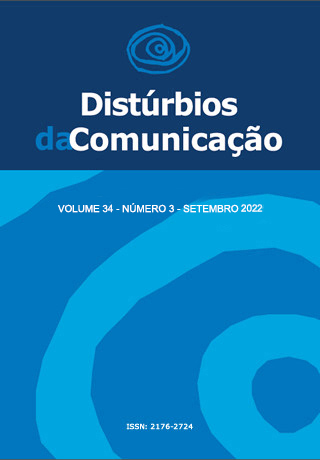Transgender women
their narrative on health, voice, and dysphoria
DOI:
https://doi.org/10.23925/2176-2724.2022v34i3e54938Keywords:
Voice, Transgender people, Social perceptionAbstract
Introduction: the transgender woman, a person who identifies and performs in femininity, has increasingly looked for vocal therapy due to gender incongruence. Objective: to know the experiences and perceptions of these women about health, gender dysphoria, voice and society, to identify possible triggering factors of their discomforts and reflect on the speech therapy performance in this context, since health, in a broad view, is biopsychosocial, while voice, is a subjective construction. Method: Cross-sectional qualitative approach, with semi-structured interviews. Participants were found by the snowball technique and evaluation of the data was obtained by content analysis. Results: participants from the State of São Paulo, most of them study and/or work. They use hormones unsupervised due to the urgency of aligning with their gender identity. Negative social experiences generate discomfort and insecurity, showing that the other’s point of view impairs self-perception. Thus, they seek passability to avoid harassment. The voice was seen as a trigger to have their bodies and gender questioned, and vocal therapy is seen as positive, for working on vocal potentialities, self-perception, and self-acceptance. Having peer support and positive transgender references provide greater self-confidence, acceptance, and reassurance in gender confirmation. Final considerations: psychosocial aspects, cisheteronormativity and demands of transgender people should be considered in transgender health care, including vocal therapy, as well as discussion about the demands of this public should be proposed in society in order to promote health and inclusion to this population.
Downloads
References
Jesus JG de. Orientações sobre identidade de gênero: conceitos e termos / Jaqueline Gomes de Jesus. Brasília, 2012.
Wittmann I. Corpo, Gênero e Identidade: Experiências transgênero na cidade de Manaus [Dissertação]. Manaus: Universidade Federal do Amazonas – UFAM; 2016.
De Tilio R. Despatologização da Transexualidade. Rev. bras. sex. hum. 2018; 29(1): 39-48. DOI: https://doi.org/10.35919/rbsh.v29i1.40
Silva D. da CP. Materialização discursiva da cis-heteronormatividade em perspectiva escalar: contribuições para a Linguística Queer. Cadernos De Linguagem E Sociedade. 2020; 21(2): 280–306. DOI: https://doi.org/10.26512/les.v21i2.35269
Meyer IH. Prejudice and Discrimination as Social Stressors. In: Meyer IH, Northridge, ME. The Health of Sexual Minorities – Public health perspectives on Lesbian, gay, bisexual and transgender populations. New York, United States: Springer, 2007.
WPATH. Normas de atenção à saúde das pessoas trans e com variabilidade de gênero. 7ªed. 2012 [acesso em 04/09/21]; Disponível em https://www.wpath.org/publications/soc.
Knudson G, De Cuypere G, Bockting W. Recommendations for Revision of the DSM Diagnoses of Gender Identity Disorders: Consensus Statement of the World Professional Association for Transgender Health,International Journal of Transgenderism. 2010; 12:2, 115-118. DOI: 10.1080/15532739.2010.509215
Adler RK, Hirsch S, Mordaunt M. Voice and Communication Therapy for Transgender/Transsexual Client - A comprehensive Clinical Guide. 2. ed. San Diego, United States: Plural Publishing Inc.; 2012.
Gunzburger D. Acoustic and perceptual implications of the transsexual voice. Arch. Sex. Behav. 1995; 24(3): 339-48. DOI: 10.1007/BF01541604
Oates J; Dacakis G. Voice change in transsexuals. Venereology. 1997; 10(3): 178-87. https://search.informit.org/doi/10.3316/ielapa.560095150854389
Strand EA. Uncovering the role of gender stereotypes in speech perception. J. Lang. Soc. Psychol. 1999; 18(1): 86-100. https://doi.org/10.1177/0261927X99018001006
Dacakis G, Oates JM, Douglas JM. Further evidence of the construct validity of the Transexual Voice Questionary (TVQ mtf) using principal analysis. J Voice. 2016; 31(2): 142-8. DOI: 10.1016/j.jvoice.2016.07.001
Scliar, M. História do Conceito de Saúde. PHYSIS: Rev. Saúde Coletiva. 2007; 17(1): 29-41. https://doi.org/10.1590/S0103-73312007000100003
Vinuto J. A amostragem em Bola de Neve na pesquisa qualitativa: Um debate aberto. Temáticas. 2014; 22(44): 203-20. DOI: https://doi.org/10.20396/tematicas.v22i44.10977
Bardin L. Análise de Conteúdo. Edições 70, Edição Revista e Atualizada; 2010.
Araruna MLFB. O direito à cidade em uma perspectiva travesti: uma breve autoetnografia sobre socialização transfeminina em espaços urbanos. Periódicus. nov.2017- abr.2018; 8(1): 133-53. DOI: https://doi.org/10.9771/peri.v1i8.23942
Zerbinati JP, Bruns MAT. A família de Crianças Transexuais: O que a Literatura Científica Tem a Dizer?. Pensando fam. dez. 2018; 22(2): 37-51. Disponível em: http://pepsic.bvsalud.org/scielo.php?script=sci_arttext&pid=S1679-494X2018000200004&lng=pt&nrm=iso. ISSN 1679-494X.
Johnson AH, Beach-Ferrara J, Rogers BA, et al. Common barriers to healthcare for transgender people in the U.S. Southeast. Int. J. Transgend Health. 2020; 21(1): 70-8. DOI: 10.1080/15532739.2019.1700203
Socías ME, Marshall BD, Arístegui, I. et al. Factors associated with healthcare avoidance among transgender women in Argentina. Int J Equity Health. 2014; 13(1): 81. DOI: 10.1186/s12939-014-0081-7
Heng A, Heal C, Banks J, et al. Clinician and client perspectives regarding transgender health: a North Queensland focus. Int J Transgend. 2019; 20(4): 434-46. DOI: 10.1080/15532739.2019.1650408
Louro GL. Gênero e sexualidade: pedagogias contemporâneas. Pro-Posições. Maio/ago, 2018; 19(2)(56): 17-23. Disponível em: https://periodicos.sbu.unicamp.br/ojs/index.php/proposic/article/view/8643470. Acesso em: 17 ago. 2022.
Prado MAM, Machado FV. Preconceito contra homossexualidades: A hierarquia da invisibilidade. São Paulo: Cortez, 2008.
Lanz L. O corpo da roupa: a pessoa transgênera entre a transgressão e a conformidade com as normas de gênero. Uma introdução aos estudos transgêneros. Curitiba: Transgente. 2015.446p.
Hancock AB, Krissinger J, Owen K. Voice Perceptions and Quality of Life of Transgender People. J Voice. Nov.2010; 25(5): 553-8. DOI: 10.1016/j.jvoice.2010.07.013
Downloads
Published
Issue
Section
License
Copyright (c) 2022 Thaís Fernandes Sebastião, Ana Carolina Constantini, Maria de Fátima de Campos Françozo

This work is licensed under a Creative Commons Attribution 4.0 International License.









